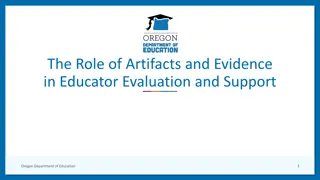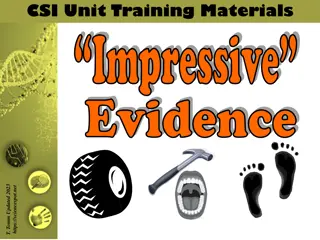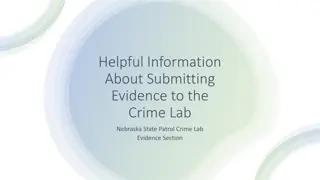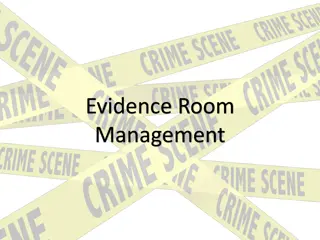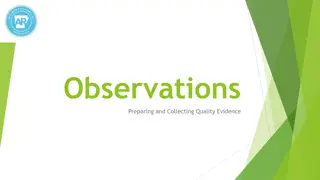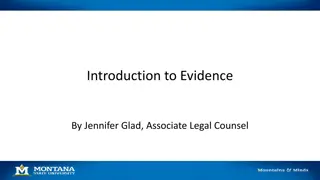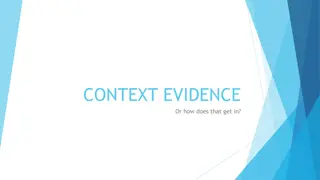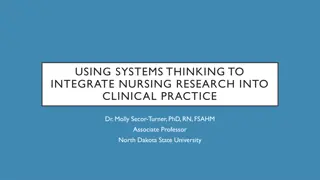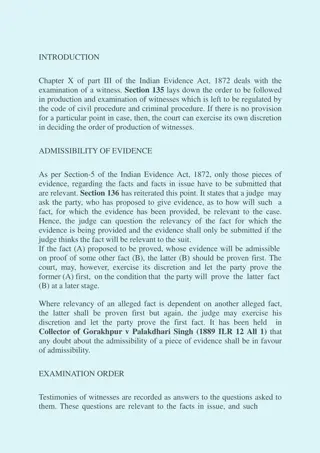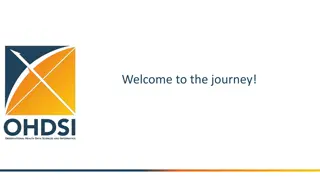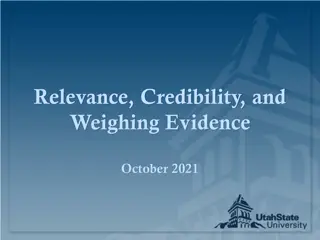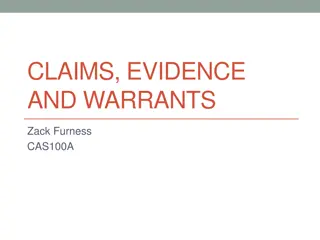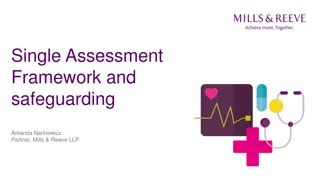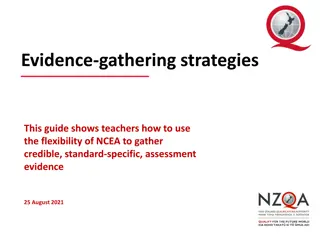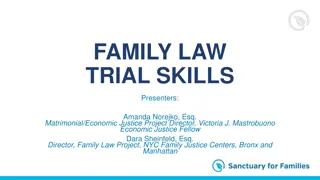
Enhancing Professional Practice: Tools and Strategies for Teacher Evaluation
Explore the work of Charlotte Danielson, Bob Marzano, and Dr. Susan Belgrad in enhancing professional practice through tools like observation artifacts, evaluation of lesson plans, classroom observations, self-assessments, and portfolio assessments. Understand the strengths and limitations of each tool and how they contribute to teacher growth and student learning outcomes.
Download Presentation

Please find below an Image/Link to download the presentation.
The content on the website is provided AS IS for your information and personal use only. It may not be sold, licensed, or shared on other websites without obtaining consent from the author. If you encounter any issues during the download, it is possible that the publisher has removed the file from their server.
You are allowed to download the files provided on this website for personal or commercial use, subject to the condition that they are used lawfully. All files are the property of their respective owners.
The content on the website is provided AS IS for your information and personal use only. It may not be sold, licensed, or shared on other websites without obtaining consent from the author.
E N D
Presentation Transcript
Enhancing Professional Practice Looking at the work of Charlotte Danielson and Bob Marzano Dr. Susan Belgrad California State University Northridge
Observation Artifacts State-Mandated Test Scores Student and Parent Surveys Dr. Susan Belgrad California State University Northridge
Evaluation Tool Review Teachers Lesson Plans Strengths Lesson plans show how well prepared teachers are to deliver content, develop student skills, and manage the classroom. The level of planning has been shown to correlate with student learning. Limitations Lesson plans are often adjusted as the lesson is taught; thus, the effectiveness of a lesson cannot be evaluated simply by looking at the plan. Adapted from EdSource's Envisioning New Directions in Teacher Evaluation. EdSource June 2011 Dr. Susan Belgrad California State University Northridge
Evaluation Tool Strengths Limitations Classroom Observations This is the most commonly used tool because it is able to capture information about instructional practices. This can be used as both a formative and as a summative assessment tool. When used in formative evaluations, the observer can track a teacher s growth and suggest needed professional development and then later observe whether changes in teaching have been made. Poorly trained observers and/or inconsistent, brief observations can lead to biased or inaccurate results. However, when observations occur more frequently, their reliability improves. Observers often are not aware of the teacher s lesson plan. If, for example, the plan requires student accommodations, it would be difficult for the evaluator to know if the accommo- dations were implemented appropriately. Adapted from EdSource's Envisioning New Directions in Teacher Evaluation. EdSource June 2011 Dr. Susan Belgrad California State University Northridge
Evaluation Tool Strengths Limitations Self-Assessments Self-reflection during grade- or subject-area meetings, debriefings, or developing a portfolio or individual professional development plan may encourage teachers to continue to learn and grow. Videotaping class sessions allows teachers to review their performance. Requires large amounts of time from the teacher. Adapted from EdSource's Envisioning New Directions in Teacher Evaluation. EdSource June 2011 Dr. Susan Belgrad California State University Northridge
Evaluation Tool Portfolio Assessments Strengths Limitations No conclusive findings exist on the reliability of portfolios as part of an objective evaluation system. Combines the usefulness of a variety of other evaluative tools, such as review of lesson plans, a video of classroom teaching, reflection, and examples of student work and teacher feedback. Promotes the active participation of teachers in the evaluation process. Allows evaluators to review non-classroom aspects of instruction. Dr. Susan Belgrad California State University Time consuming for both teachers and administrators. Adapted from EdSource's Envisioning New Directions in Teacher Evaluation. EdSource June 2011 Northridge
Evaluation Tool Student Work-Sample Reviews Strengths Limitations Reviewing samples can be time consuming. More prone to issues of validity and reliability than test items that have been validated for similar comparisons across different students in different schools answering similar test items. However, a way to reduce such subjectivity would be to develop a research-informed scoring rubric and train those who use it. May be able to identify which elements of teaching have a positive effect on learning better than standardized test scores. Adapted from EdSource's Envisioning New Directions in Teacher Evaluation. EdSource June 2011 Dr. Susan Belgrad California State University Northridge
What are four difficulties of test scores as sources of teacher evaluation? 1. 2. 3. 4. Dr. Susan Belgrad California State University Northridge
Formal vs. informal 1. Announced vs. unannounced observations 2. Collectors and providers of evidence 3. Consistency of scoring 4. Use of forms in a systematic or random manner 5. Dr. Susan Belgrad California State University Northridge
From C. Danielson Webinar Series Dr. Susan Belgrad California State University Northridge
From C. Danielson Webinar Series Dr. Susan Belgrad California State University Northridge
Research tells us that the role of the teacher is the single greatest factor on student learning.(Sanders & Horn, 1998) . Research also tells that one of the greatest factors central office [administrators] can contribute is to maintain a singular focus on improving instruction. (Marzano and Waters, 2009) Research tells us that an improved focus on teacher evaluation and professional development will improve retention of teachers S.M. Johnson, J.H. Berg, M.L. Donaldson. (2005). Dr. Susan Belgrad California State University Northridge
Student achievement will not improve unless teaching improves. Teachers working alone without feedback will not be able to improve no matter how much professional development they receive. The challenge is to create a system of continuous improvement of instruction, supervision and instructional leadership Supervision needs to be frequent and focused on the improvement of instruction Marzano Evaluation Model Implementation Services Dr. Susan Belgrad California State University Northridge
Communicate the common language of teaching efficiently Facilitate the observation and feedback cycle Promote teacher reflection and collaboration Offer targeted & aligned professional development Provide conditions for deliberate practice Connect growth, development and performance management www.MarzanoEvaluation.com Dr. Susan Belgrad California State University Northridge
Looking at the Desired Results of Effective Teacher Evaluation as advanced by Danielson and Marzano, what do you see as important in showing evidence of your professional craft as a teacher? Accountability Growth A Culture of Learning Skilled Observation and Evaluation Involvement of Teachers in the Design of the Process Link To Student Learning Dr. Susan Belgrad California State University Northridge
Looking at the Desired Results of Effective Teacher Evaluation as advanced by Danielson and Marzano, what do you see as important in showing evidence of your professional craft as a teacher? Self Report of Practice Observation Evidence Binder/Portfolio Student Survey Artifact Analysis Video Evidence Dr. Susan Belgrad California State University Northridge
Danielson, C. (2007) Handbook on the Framework for Professional Development. Arlington VA: ASCD. Marzano , R. and Waters, T. (2009) District Leadership That Works: Striking the Right Balance. Bloomington, IN: Solution Tree. Sanders, W.L. & Horn, S.P. (1998). Research Findings from the Tennessee Value- Added Assessment System (TVAAS) Database: Implications for Educational Evaluation and Research. Journal of Personnel Evaluation in Education,12(3),247-256. SandersW. L, (2004) A summary of conclusions drawn from longitudinal analysis of student achievement data over the past 22 years. Paper presented to Governors Education Symposium, Ashville, NC.http://www.sas.com/govedu/edu/hunt_summary.pdf S.M. Johnson, J.H. Berg, M.L. Donaldson. (2005, January). Who Stays in Teaching and Why: A Review of the Literature on Teacher Retention. The Project on the Next Generation of Teachers, Harvard Graduate School of Education. http://assets.aarp.org/www.aarp.org_/articles/NRTA/Harvard_report.pdf Dr. Susan Belgrad California State University Northridge

